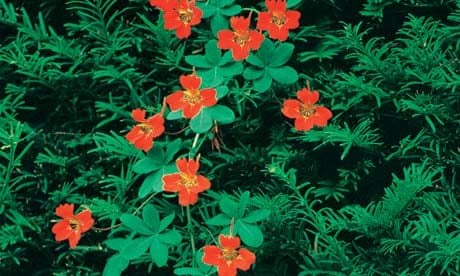I am running out of space; I suppose it was always going to happen in a small garden. All I am left with is the space that I carve out of thin air. Every garden has its vertical spaces. This is not just about fences or walls but also arbours, archways, obelisks, pergolas and tripods.
In tiny balconies or courtyards, using trellises, mounted pots and planters on walls leaves floors free for a small table and a chair or two. In larger areas, verticals add structure and intrigue.
Plants have adapted extraordinarily well to making the most of these spaces. Ever ready to exploit new territory, they have come up with numerous ways to clamber, scramble and climb towards the top.
Understanding a little about the way your climber heads will help you choose the right structure for it. Clinging tendrils need lots of things to attach to which can make use of both vertical and horizontal spaces; netting, pea sticks and grids are all ideal. Those that spiral use only vertical supports, so if you use a grid you will always see it – hence the classic bean tripod. Scramblers and trailers need to be tied in or they will go wayward.
Many perennial climbers live for decades, so there's little point growing a rose up a frame that doesn't last. Hazel poles are probably out for roses, but are great for herbaceous clematis and annual vegetables. Chestnut poles offer a little more longevity, metal more so. Both are better suited to roses, jasmines, honeysuckle and vines. If you have a large tree, make it earn its keep and send something up it; a rampant rose or clematis for those that are sturdy. For smaller trees and large bushes, use annuals such as climbing nasturtiums or morning glories (ipomoea).
If you want to cover walls, then you have two options: wires or strong trellis mounted away from the wall to allow air circulation. On these, train espalier trees such as figs, apples or flowering shrubs such Fremontodendron 'California Glory' (a little 70s but in a good way). The other option is climbers with adventitious roots, such as Hydrangea anomala subsp. petiolaris. In the long term, some of these can have an effect on the wall – ivy damaging brick pointing, say. Keep them in check with regular pruning.
Wall-mounted pots and planting pockets are ideal for smaller spaces. Choose fast-growing annuals such as herbs, coleus, trailers such as petunias, pelargonium and lobelias. Now the garden has subdued, play around with these structures: try out archways in different spaces, rest trellises against the wall. By the time growth resumes, you should have them in the right place.

Comments (…)
Sign in or create your Guardian account to join the discussion